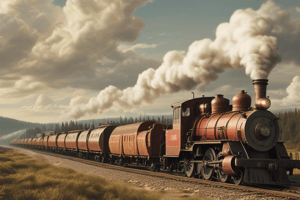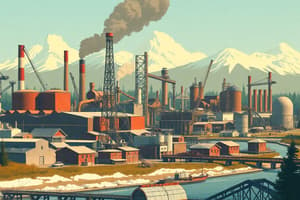Podcast
Questions and Answers
What was a primary characteristic of the First Industrial Revolution?
What was a primary characteristic of the First Industrial Revolution?
Which of the following is NOT a push factor for immigrants to Canada during 1890-1914?
Which of the following is NOT a push factor for immigrants to Canada during 1890-1914?
During which period did the Second Industrial Revolution take place?
During which period did the Second Industrial Revolution take place?
What was a significant consequence of industrialization in Canada between 1891 and 1911?
What was a significant consequence of industrialization in Canada between 1891 and 1911?
Signup and view all the answers
Which of the following best describes a multicultural society?
Which of the following best describes a multicultural society?
Signup and view all the answers
Where were most industrial changes in Canada concentrated during this period?
Where were most industrial changes in Canada concentrated during this period?
Signup and view all the answers
What was a major development associated with the Second Industrial Revolution?
What was a major development associated with the Second Industrial Revolution?
Signup and view all the answers
Which factor contributed to the rapid population increase in Canadian cities from 1891 to 1911?
Which factor contributed to the rapid population increase in Canadian cities from 1891 to 1911?
Signup and view all the answers
What was one of the main provisions of the Manitoba Act of 1870?
What was one of the main provisions of the Manitoba Act of 1870?
Signup and view all the answers
What was a significant factor leading to ethnic communities forming in Canada?
What was a significant factor leading to ethnic communities forming in Canada?
Signup and view all the answers
Which group expressed opposition to the changes brought about by the Manitoba Act?
Which group expressed opposition to the changes brought about by the Manitoba Act?
Signup and view all the answers
What was a compromise reached between Wilfrid Laurier and Thomas Greenway?
What was a compromise reached between Wilfrid Laurier and Thomas Greenway?
Signup and view all the answers
Which statement reflects a misconception about the Manitoba Act?
Which statement reflects a misconception about the Manitoba Act?
Signup and view all the answers
What was the linguistic situation in Manitoba during the significant immigration period of the 1880s?
What was the linguistic situation in Manitoba during the significant immigration period of the 1880s?
Signup and view all the answers
The decision-making process after the Manitoba Act was characterized by which approach?
The decision-making process after the Manitoba Act was characterized by which approach?
Signup and view all the answers
Which was NOT a factor in the dissatisfaction among Francophone Canadians regarding the Manitoba Act?
Which was NOT a factor in the dissatisfaction among Francophone Canadians regarding the Manitoba Act?
Signup and view all the answers
Study Notes
Canada, 1890-1914: A Changing Society
- The period from 1890 to 1914 saw significant industrialization in Canada.
- A factory in Ontario in 1903 is displayed as an example.
- Population increased by 2.4 million between 1891 and 1911.
- Most immigrants settled in cities during this time.
- Industrialization is the development of industries on a national scale.
Industrialization
- Industrialization led to a shift from agriculture and resource extraction to manufacturing.
- New transportation technologies, such as railways and canals, played a role in this shift.
- The widespread use of machines in textile production, steam engines, and factories significantly boosted the economy.
First Industrial Revolution
- This revolution occurred from the 1780s to the 1860s.
- A key characteristic of this revolution was the movement away from agricultural practices towards manufacturing.
- New transportation systems like canals and railroads were developed.
- The use of machinery became important for producing goods like textiles, with steam engines and other factory-based technology increasing production.
Second Industrial Revolution
- This revolution took place from the 1860s to the 1950s.
- A defining feature was the rise of large factories and the use of automation in manufacturing processes.
- Companies improved methods for production.
- The automobile industry emerged as a major part of this industrial change.
- Factories were used to create affordable but durable automobiles (like the Ford model).
Second Industrial Revolution - Impacts
- Most industrial changes happened in Ontario and Quebec.
- Many farmers and villagers moved to cities in search of jobs.
- Working conditions in cities were often dangerous.
Why Immigrate?
- People immigrated to Canada for various reasons.
- These reasons are categorized as push and pull factors.
- Push factors motivate people to leave their home countries (e.g., famine, war, disease, lack of land, lack of personal freedom, unemployment, drought).
- Pull factors attract people to a new country (e.g., free land, religious freedom, political freedom, lifestyle improvement, excellent farming conditions, education opportunities, advanced technology).
- Various cultures arrived in Canada during this period.
- Many immigrants did not speak fluent English or French.
Multicultural Societies
- Canada became a multicultural society.
- People of diverse races, ethnicities, and nationalities lived together.
- Ethnic communities formed as immigrants from different parts of the world arrived.
Free Land and the Immigration to the Wheat Belt
- Canada offered free land to encourage immigration.
- Families could obtain 65 hectares of land.
- Canada attracted many immigrants due to these land opportunities.
- Many immigrants did not speak fluent English or French.
The Manitoba Act
- The Manitoba Act of 1870 established certain rights for French and English Canadians.
- This Act ensured that both Catholic and Protestant schools would exist.
- It also protected the rights of French and English in the courts.
- This ensured that both groups had equal rights within the society.
The Manitoba Act: Immigration and Diversity
- Significant immigration occurred in Manitoba during the 1880s.
- Immigrants arrived from various countries.
- English became a primary language among the immigrants.
- Francophones were outnumbered in most communities in Manitoba during this time.
Manitoba Act: Opposition and Compromise
- French Catholics opposed the changes made in the Manitoba Act.
- They felt the Act was an attack on their language, culture, and rights.
- Francophone Canadians in other provinces worried about similar actions being taken elsewhere.
- Pressure was put on the government to reverse the decision.
- In the end, Laurier (Prime Minister) made a compromise with the Manitoba premier.
- The end result was 30 minutes of religious instruction per day at school.
- Teachers were hired according to the needs of the communities and school enrollment.
The Manitoba Act: Compromise and Middle Ground
- Neither side was fully satisfied with the outcome of the Manitoba Act
- It was a middle ground between opposing views.
- Changes were to be made on a case-by-case basis.
- There was no protection for the French language or culture as a result.
Studying That Suits You
Use AI to generate personalized quizzes and flashcards to suit your learning preferences.
Related Documents
Description
This quiz explores the transformation of Canada from 1890 to 1914, focusing on the significant industrialization during this period. It highlights population growth, urban immigration, and technological advancements in transportation that shaped the nation's economy. Test your knowledge on the societal changes brought by industrialization and its historical context.




